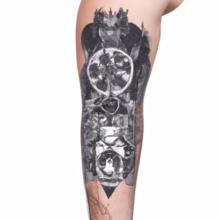The Confused History of Prison Tattoos
Prison Tattoos: Symbols of Identity, Power, and Survival
Prison tattoos have long been a distinctive feature of the penal system across the world. These tattoos are not just marks on the skin; they are symbols loaded with meaning, representing various aspects of prison culture, such as identity, rank, loyalty, and personal stories. From Russia to the United States, prison tattoos vary widely in their design and significance, but they all serve as a form of non-verbal communication within a closed environment. They convey messages about an individual’s criminal history, affiliations, and even aspirations. More than mere body art, prison tattoos reflect the complex social structures and codes that exist behind bars, making them an integral part of prison subculture.
Origins and Functions of Prison Tattoos
Prison tattoos have existed for centuries, with their roots in various ancient cultures. However, they gained prominence during the 19th and 20th centuries, as penal systems around the world expanded. In the past, tattoos were often used to mark prisoners as punishment or as a form of control. For instance, in 18th-century Britain, convicts were branded with tattoos as a sign of their criminal status. Over time, prisoners themselves began to adopt tattooing as a means of expressing their own identity and resistance to authority.
Within prison walls, tattoos take on a number of functions. First and foremost, they are used to display gang affiliation or personal identity. In many prisons, especially in the United States, inmates are often grouped by race or gang, and their tattoos reflect this allegiance. For example, members of the Aryan Brotherhood, a notorious white supremacist gang, might wear tattoos with Nazi symbols or runes. Meanwhile, Hispanic gangs might use intricate designs involving Aztec symbols, religious imagery, or the Virgin Mary.
These tattoos also serve as status symbols. The more tattoos a prisoner has, the more “respect” they may command from fellow inmates. Some tattoos denote rank within a gang, while others mark significant life events, like surviving a long sentence or enduring solitary confinement. A prison tattoo can also be a mark of defiance, signaling that the wearer is unafraid of the consequences of breaking prison rules or challenging the authorities.
Types of Prison Tattoos
Prison tattoos vary greatly depending on the region, the culture of the inmates, and the particular prison. However, there are several designs that are common across different prison systems.
- Teardrop Tattoos: One of the most well-known prison tattoos is the teardrop, usually inked near the eye. This tattoo often symbolizes that the wearer has committed murder or lost someone close to them. The interpretation of the teardrop tattoo varies by location, but it generally signals a tough, violent history.
- Three Dots (Triangle): In the U.S. and Europe, the three dots arranged in a triangle is a common prison tattoo symbolizing “mi vida loca” or “my crazy life.” It represents a life of crime, gang involvement, and a lack of fear for law enforcement. This tattoo is often seen on hands, arms, or near the eyes.
- Spider Web Tattoos: Spider webs, usually tattooed on the elbow, represent a lengthy period spent in prison. The idea is that the inmate has been “stuck” in prison for so long that spiders have had time to spin their webs. This design is common in both the U.S. and Europe, especially among white inmates.
- Barbed Wire Tattoos: Barbed wire, often tattooed around the arm or forehead, is another prison tattoo that symbolizes incarceration. In many cases, the number of barbs on the wire corresponds to the number of years the prisoner has spent behind bars.
- Russian Criminal Tattoos: Russia is particularly famous for its intricate and highly symbolic prison tattoo culture. These tattoos are deeply tied to the prison hierarchy. For instance, stars tattooed on the shoulders signify that the wearer holds a high rank in the criminal world, while tattoos of religious figures may indicate disdain for authority. A common Russian prison tattoo is a skull or crossbones, symbolizing a thief or criminal.
The Process of Getting a Prison Tattoo
Tattooing inside prisons is typically forbidden, and as a result, inmates have to be resourceful. The equipment used to create prison tattoos is often improvised from everyday objects. Tattoo machines might be fashioned from motors taken from electric razors, pens, or cassette players, while ink can be made from melted plastic, soot, or even pen ink mixed with water.
The process itself is often painful and unsanitary, leading to potential health risks such as infections, bloodborne diseases like hepatitis, and complications from poorly made ink. However, despite the risks, the significance of prison tattoos often outweighs the dangers. For many inmates, getting a tattoo is a rite of passage and a necessary part of integrating into the prison community.
The Meaning of Prison Tattoos in Society
While prison tattoos are primarily associated with criminal life, they also serve as a stark reminder of the harsh realities of incarceration. These tattoos are a form of survival in an environment where trust is rare, and power dynamics are constantly shifting. They help inmates forge identities and alliances in a world where individuality is often suppressed.
Moreover, once inmates are released, prison tattoos can follow them into the outside world. These tattoos may continue to carry stigmas, making it harder for ex-convicts to reintegrate into society. In some cases, former prisoners choose to remove or cover their prison tattoos to avoid being marked by their past, while others proudly display them as a testament to their survival.
Conclusion
Prison tattoos are far more than mere decoration; they are loaded with meaning, serving as both a form of communication and a survival tool within the harsh world of incarceration. By understanding the stories behind prison tattoos, we gain insight into the complex social hierarchies, traditions, and codes of conduct that define life behind bars.



